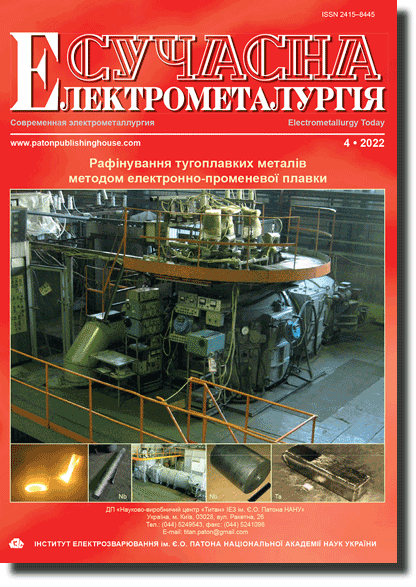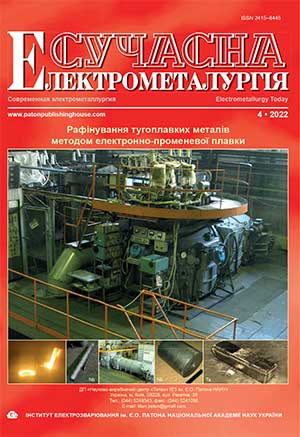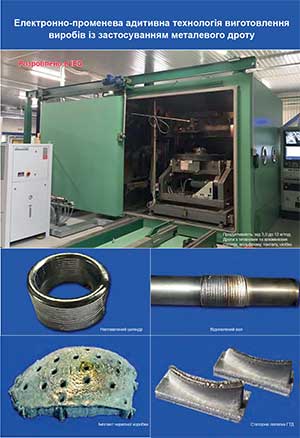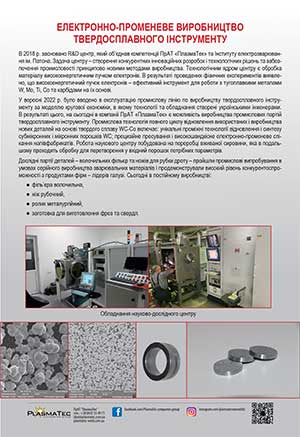| 2022 №04 (01) |
DOI of Article 10.37434/sem2022.04.02 |
2022 №04 (03) |
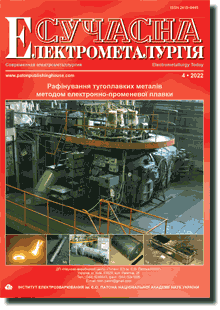
"Suchasna Elektrometallurgiya" (Electrometallurgy Today), 2022, #4, 9-14 pages
The influence of copper on the heat resistance of thin foils of high-entropy alloys of the Cr–Fe–Co–Ni–Cu system obtained by the electron beam deposition method
A.I. Ustinov, S.O. Demchenkov, T.V. Melnychenko, O.Yu. Klepko
E.O. Paton Electric Welding Institute of the NAS of Ukraine. 11 Kazymyr Malevych Str., 03150, Kyiv, Ukraine. E-mail: office@paton.kiev.ua
Abstract
High-entropy alloys are characterized by a complex of mechanical properties, which allows them to be considered promising structural materials. Given that the phase composition of high-entropy alloys remains stable with increasing temperature, it is assumed that they can be used to manufacture structural elements of aerospace equipment operated at elevated temperatures. Electron beam technology makes it possible to obtain thin-sheet material based on these alloys, which greatly simplifies the technology of manufacturing thin-walled elements, such as light heat-shielding honeycomb panels for thermal protection of aircraft. In this regard, the paper investigated the heat resistance of thin-sheet materials based on the Cr–Fe–Co–Ni–Cu system, depending on the copper content in the alloy. It is shown that the content of copper in the composition of high-entropy alloys significantly affects the heat resistance of the material: in the case of CrFeCoNiCu alloy foils, the increase in specific mass at a temperature of 900 °С occurs 8 times more intensively than in CrFeCoNi foils, due to the activation of the diffusion of copper atoms, its release to the surface of the foil and scale formation based on CuO and NiO oxides with a significant number of defects in the structure. CrFeCoNi alloy foils are characterized by higher heat resistance due to the formation of scale on the surface based on Cr2O3 oxide with fewer defects and greater integrity. The average mass growth rate of the CrFeCoNi alloy sample is about 0.041 mg/(cm2∙h). Ref. 16, Tabl. 2, Fig. 3.
Keywords: high-entropy alloys; electron beam deposition; ingot; thin foils; heat resistance; microstructure
Received 15.07.2022
References
1. Ivanov, I.I., Yasinsky, K.K. (1996) Efficiency of application of heat-resistant alloys based on Ti3Al and TiAl intermetallics for operation at 600-800 °C temperatures in aerospace engineering. Tekhnologiya Lyogkikh Splavov, 3, 7-12 [in Russian].2. Frolov, G.A., Sontsev, V.P., Tikhij, V.G., Gusarova, I.A. (2011) Advanced materials for multilayer thermal protection structures of reusable space vehicles. Space engineering. Rocket arming. Dnepropetrovsk, 133-145 [in Russian].
3. Murty, B.S., Yeh, J.W., Ranganathan, S. (2014) Chapter 2. High-entropy alloys: Basic concepts. High entropy alloys. Butterworth-Heinemann, 13-35. https://doi.org/10.1016/B978-0-12-800251-3.00002-X
4. Tong, C.J., Chen, M.R., Chen, S.K. et al. (2005) Mechanical performance of the AlxCoCrCuFeNi high-entropy alloy system with multiprincipal elements. Metallurgical and Materials. Transact. A, 36, 1263-1271. https://doi.org/10.1007/s11661-005-0218-9
5. Chuang, M.H., Tsai, M.H., Wang, W.R. et al. (2011) Microstructure and wear behavior of AlxCo1.5CrFeNi1.5y high-entropy alloys. Acta Materialia, 59, 6308-6317. https://doi.org/10.1016/j.actamat.2011.06.041
6. Wu, Z., David, S.A., Feng, Z., Bei, H. (2016) Weldability of a high entropy CrMnFeCoNi alloy. Scripta Materialia, 124, 81-85. https://doi.org/10.1016/j.scriptamat.2016.06.046
7. Dafang, W., Liming, Z., Bing ,P. et al. (2016) Thermal protection performance of metallic honeycomb core panel structures in non-steady thermal environments. Experimental Heat Transfer, 29(1), 53-77. https://doi.org/10.1080/08916152.2014.940433
8. Gusarova, I.A., Parko, M., Potapov, A.M. et al. (2016) Evaluation of high temperature resistance of three-layer honeycomb panel produced from YuIPM-1200 alloy by vacuum diffusion welding, The Paton Welding J., 12, 31-35. https://doi.org/10.15407/tpwj2016.12.05
9. Braeckman, B.R., Boydens, F., Hidalgo, H. et al. (2015) High entropy alloy thin films deposited by magnetron sputtering of powder targets. Thin Solid Films, 580, 71-76. https://doi.org/10.1016/j.tsf.2015.02.070
10. Sobol`, O.V., Andreev, A.A., Gorban, V.F. (2012) Reproducibility of the single-phase structural state of the multielement high-entropy Ti-V-Zr-Nb-Hf system and related superhard nitrides formed by the vacuum-arc method. Technical Physics Letters, 38(7), 616-619. https://doi.org/10.1134/S1063785012070127
11. Huang, P.K., Yeh, J.W., Shun, T.T., Chen, S.K. (2004) Multi-principal-element alloys with improved oxidation and wear resistance for thermal spray coating. Advanced Engineering Materials, 6, 74-78. https://doi.org/10.1002/adem.200300507
12. Zhang, H., Pan, Y., He, Y. et al. (2010) Synthesis and characterization of NiCoFeCrAl3 high entropy alloy coating by laser cladding. Advanced materials Research, 97-101, 1408-1411. https://doi.org/10.4028/www.scientific.net/AMR.97-101.1408
13. Ustinov, A.I., Polishchuk, S.S., Demchenkov, S.A., Melnichenko, T.V. (2019) Producing of thick vacuum condensates of high-entropic alloys CrFeCoNiCu and AlCrFeCoNiCu by the method of electron beam deposition. Suchasna Elektrometal., 2, 13-21[in Ukrainian]. https://doi.org/10.15407/sem2019.02.03
14. Ustinov, A.I., Polishchuk, S.S., Demchenkov, S.A. et al. (2020) Formation of thin foils of high-entropy CrFeCoNiCu alloys by EB-PVD process. Surface and Coatings Technology, 403, 126440. https://doi.org/10.1016/j.surfcoat.2020.126440
15. Ustinov, A.I., Skorodzievskii, V.S., Demchenkov, S.A. et al. (2020) Effect of the structure of vacuum condensates of high entropy alloys of Cr-Fe-Co-Ni-Cu system on their mechanical properties. Suchasna Elektrometal., 4, 16-22 [in Ukrainian]. https://doi.org/10.37434/sem2020.04.03
16. Ustinov, A.I., Demchenkov, S.A., Melnychenko, T.V. et al. (2021) Effect of structure of high entropy CrFeCoNiCu alloys produced by EB PVD on their strength and dissipative properties. J. of Alloys and Compounds, 887, 161408. https://doi.org/10.1016/j.jallcom.2021.161408
Advertising in this issue:
The cost of subscription/purchase order journals or individual articles
| Journal/Currency | Annual Set | 1 issue printed |
1 issue |
one article |
| TPWJ/USD | 384 $ | 32 $ | 26 $ | 13 $ |
| TPWJ/EUR | 348 € | 29 € | 24 € | 12 € |
| TPWJ/UAH | 7200 UAH | 600 UAH | 600 UAH | 280 UAH |
| AS/UAH | 1800 UAH | 300 UAH | 300 UAH | 150 UAH |
| AS/USD | 192 $ | 32 $ | 26 $ | 13 $ |
| AS/EUR | 180 € | 30 € | 25 € | 12 € |
| SEM/UAH | 1200 UAH | 300 UAH | 300 UAH | 150 UAH |
| SEM/USD | 128 $ | 32 $ | 26 $ | 13 $ |
| SEM/EUR | 120 € | 30 € | 25 € | 12 € |
| TDNK/UAH | 1200 UAH | 300 UAH | 300 UAH | 150 UAH |
| TDNK/USD | 128 $ | 32 $ | 26 $ | 13 $ |
| TDNK/EUR | 120 € | 30 € | 25 € | 15 € |
AS = «Automatic Welding» - 6 issues per year;
TPWJ = «PATON WELDING JOURNAL» - 12 issues per year;
SEM = «Electrometallurgy Today» - 4 issues per year;
TDNK = «Technical Diagnostics and Non-Destructive Testing» - 4 issues per year.





